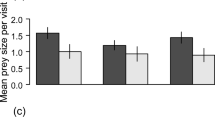Abstract
When birds raised by another species become adults, they (if they are non-brood-parasitic species) usually attempt to mate with birds of their foster species rather than with birds of their own species, a phenomenon called sexual imprinting. Avian brood parasites lay their eggs in nests of other species (the hosts) that rear the young, but the problem of sexual imprinting among brood parasites has generally been neglected, and brood parasites have been considered as an exception among birds. Here, we show, with data from field observations and field experiments, firstly, that adult great spotted cuckoos Clamator glandarius sometimes maintain contact with both older nestling and fledgling cuckoos. Adult cuckoos visited parasitized nests during the last days of the nestling period (5 observations) and, when parasitic chicks left the nest, adult cuckoos maintained contact with the young (14 observations). Adults and fledgling cuckoos communicated vocally (5 observations), and an adult great spotted cuckoo even fed a parasite fledgling in two cases. Secondly, when experimentally cross-fostered in nests of magpie Pica pica hosts outside the parasite breeding range (thus avoiding visual and acoustic communication with adult cuckoos), young cuckoos did not learn to recognize their own species when only one cuckoo chick was introduced per nest, but they learnt to recognize conspecifics when two cuckoos were reared together. This means that young great spotted cuckoos apparently must learn to recognize conspecifics, that is, recognition is not innate. Social interactions between adult brood parasites and young have also been reported in other brood parasites; thus, brood parasites are probably not an exception to the general phenomenon of imprinting, and young brood parasites may need to be imprinted on conspecifics, although more studies on other brood parasite species are needed to confirm this.
Similar content being viewed by others
Author information
Authors and Affiliations
Additional information
Received: 7 January 1999 / Accepted after revision: 27 February 1999
Rights and permissions
About this article
Cite this article
Soler, M., Soler, J. Innate versus learned recognition of conspecifics in great spotted cuckoos Clamator glandarius . Anim Cogn 2, 97–102 (1999). https://doi.org/10.1007/s100710050029
Issue Date:
DOI: https://doi.org/10.1007/s100710050029




